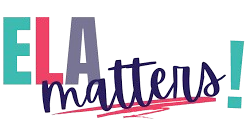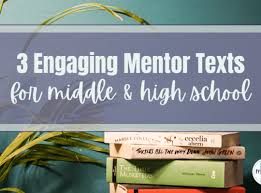If you’re looking for fun and engaging ways to incorporate mentor texts into the secondary ELA classroom, read on for 3 mentor texts your secondary ELA students will love.
How to use Mentor texts in the Secondary Classroom
Before we jump into which mentor texts to choose, let’s touch base on how to use mentor texts for teaching writing.
Mentor texts can refer to anything from singular sentences to picture books to full-blown novels or epic poems. Literally ANY (well-written) text can be used in the classroom as a mentor text.
The key to incorporating mentor texts is to start with the end in mind. This means choosing the focus for writing BEFORE getting started. When thinking about choosing your focus, ask yourself: what specifically do you want students to emulate from the mentor text when they write? This might be the grammar, the syntax, the use of punctuation, or something more content-oriented, like plot, character development, topic … the sky’s the limit!
Once you’ve identified your end-goal, guide your students through annotating the poem with that specific purpose in mind. In other words, you want to guide students to pay particular attention to something specific based on the writing goal.
Mentor Text #1: My Name by Sandra Cisneros
Why My Name is the perfect mentor text:
This short piece is actually an excerpt from Cisneros’ novel, The House on Mango Street. It walks the line between poetry and prose beautifully while exploring the rich history of the narrator’s name and the women in her family.
Students love this piece because it is beautiful, short, and deceptively “easy” to read. This means all the language is simple enough, yet Cisneros’ use of language and literary devices make the text so incredibly rich for analysis.
How to use My Name for teaching writing:
I love to introduce this short piece at the beginning of the year as part of my back-to-school curriculum, so I love to zero in on the connection between family, names, and identity.
I guide my students to look for Cisneros’ use of diction, imagery, simile, and metaphor before asking my students to write their own version of the excerpt.
Depending on the writing focus of the unit or school year, I sometimes ask students to take a personal narrative approach, breaking down the topic of each paragraph. For each paragraph, I provide prompts that connect to what Cisneros wrote in My Name, so that students can use My Name as a guide.
Other years, I invite students to write for a more fictional genre, offering a prompt in which they explore the origin of their own name (if they know it) or to create an origin story for a character of their creation’s name.
Either way, students have so much fun with these writing activities and I love getting to know my students through the stories they share!
In order to ensure students are practicing with the specific devices we studied while reading, I require them to incorporate a few of those devices and to explain their use in the reflection at the end of the activity. For example, I might ask students to choose 2 or 3 places where they used diction intentionally and to explain their intention behind the word they chose. (spoiler alert: this is a GREAT way to start preparing students for writing literary analysis later in the school year!)
Click here to check out some ready-to-go resources for using My Name by Sandra Cisneros to teach writing.
Mentor Text #2: Where I’m From by George Ella Lyon
Speaking of mentor texts for back-to-school season, I love using George Ella Lyon’s Where I’m From for introducing poetry (in a not-scary way!) and exploring “list poetry” with my students.
Why Where I’m From is the perfect mentor text:
Like My Name, Where I’m From is an accessible and engaging text that students can understand from the very get-go. This makes it an excellent choice for the start of a new school year or for introducing poetry, which many students find intimidating.
But the real thing that makes Where I’m From so special in the classroom is how much depth this poem hides. It uses everyday language and simple sentence structures, so students are surprised when they start to annotate the poem and unravel the complex story that lies beneath this sweet, seemingly simple poem.
How to use Where I’m From for teaching writing:
If you’re first introducing students to writing their own poetry, Where I’m From is the perfect mentor text because of its “list” form.
List poems are fun and low-stakes, and turn out amazingly well – your students will be so proud of the poems they write.
I like to start by analyzing some of the devices and writing structures Lyon uses by dissecting the poem to see what’s making it so interesting. We identify allusions, alliteration, repetition, and some areas with specific word choice.
Once we’ve thoroughly analyzed Lyon’s craft, I guide my students through various categories to brainstorm what they might include in their own poems. Some categories students love to brainstorm are important places, foods they grew up eating, and common phrases or advice they heard in their home growing up.
You can find my resources for teaching Where I’m From here if you’d like a little more guidance.
Mentor Text #3: The Hill We Climb by Amanda Gorman
Why The Hill We Climb is the perfect mentor text:
Amanda Gorman read her poem, The Hill We Climb, at President Joe Biden’s inaugural address in 2021, and was met with widespread praise by critics and fans alike.
The poem explores themes of unity, hope, resilience, and reconciliation. Gorman’s poem easily engages students because of its accessible language and format and its timely response to the many divisive events taking place in the U.S.
The Hill we Climb is an excellent way to introduce a poetry unit, social justice unit, or as a way to celebrate important events like National Poetry Month or Black History Month.
How to use The Hill We Climb for teaching writing:
As a spoken word poem (sometimes called performance poetry), this poem is a perfect way to introduce or review sound devices like repetition or alliteration, as well as her use of paradox.
After we’ve analyzed the poem together as a class, I invite students to try their hand at writing their own slam poem. This can seem like an intimidating task at first glance, but the poems my students write each time have been absolutely amazing.
Here’s how:
- This task is a perfect collaborative writing project, so put your students into groups of 3-4 students.
- Ask students to brainstorm a list of problems in today’s society – they can think on a micro level, such as specific problems in their school, or on a macro level, such as problems with global warming or water scarcity.
- Let students draft – I like to tell my students that there’s no need to be poetic at this stage of the game – we can go back and add in all the great meter and sound effects we’ve been talking about, but first we need a draft to work with. Students think through the problem, how It got started, who is affected, how we can fix it, etc.
- Once students have a draft worked out, invite them to think through the draft, keeping in mind those sound devices we discussed earlier – how can they add repetition, alliteration, or a few sentences that contain paradox – after all, there are paradoxes are easy to find in many of the problems we face today.
- Last step – see if any students will be willing to “perform!” I love to ask them to alternate readers as well as to choose a few lines to read at the same time as other members in their group for a very cool “choral” effect.
If you’re interested in other ways to incorporate Gorman’s work in your classroom, check out these 3 fun activities to use with Amanda Gorman’s writing.
PS…
If asking your students to write creatively has you feeling guilty, don’t fret: One of the most overlooked benefits of teaching writing with mentor texts, is that even if students aren’t writing analytical writing, they’re still working that muscle – here’s how: When you ask them to write a fictional or creative piece in which they have to think through their own word choice or use specific devices, they take a much more active role in thinking about the effect of these devices. In other words, they know what effect they’re trying to achieve and they begin thinking through how to get there with their writing, whether through sound devices, imagery, syntactical choices, or diction. This thoughtful use of devices makes them better able to identify the effects of an author’s choices around these same devices the next time they’re analyzing a piece!

